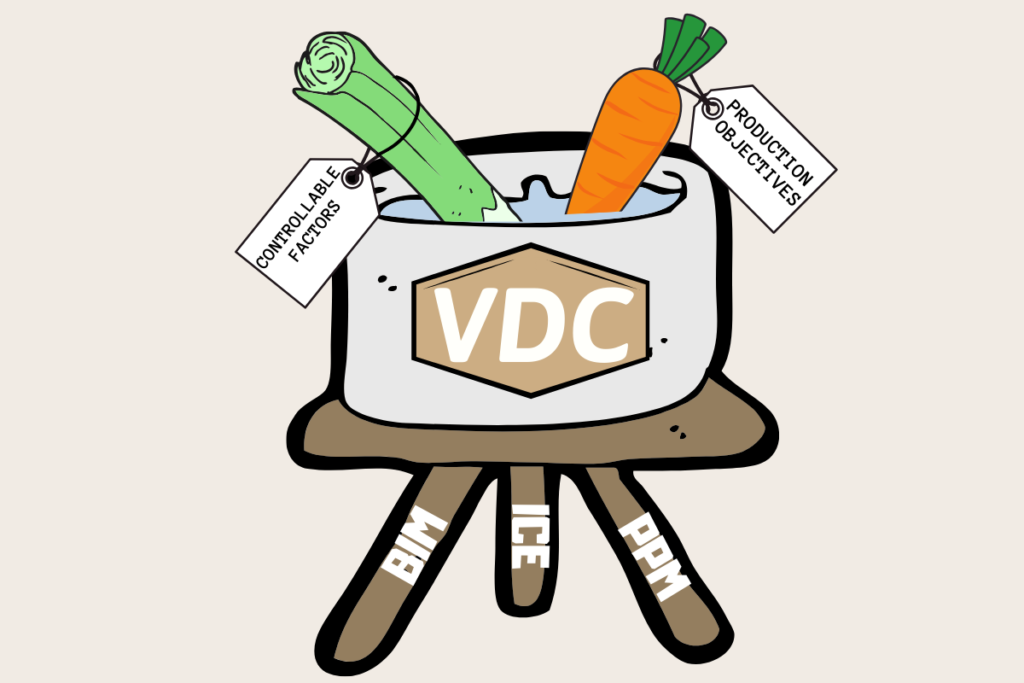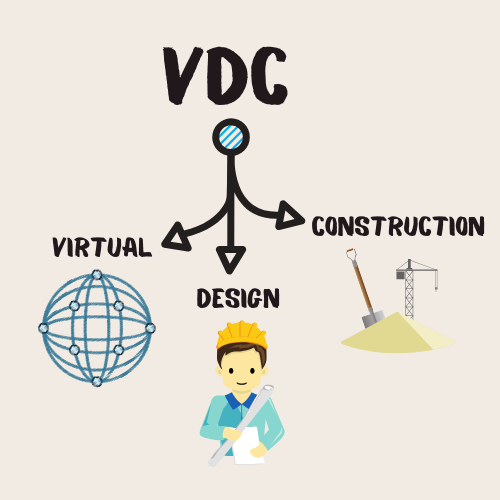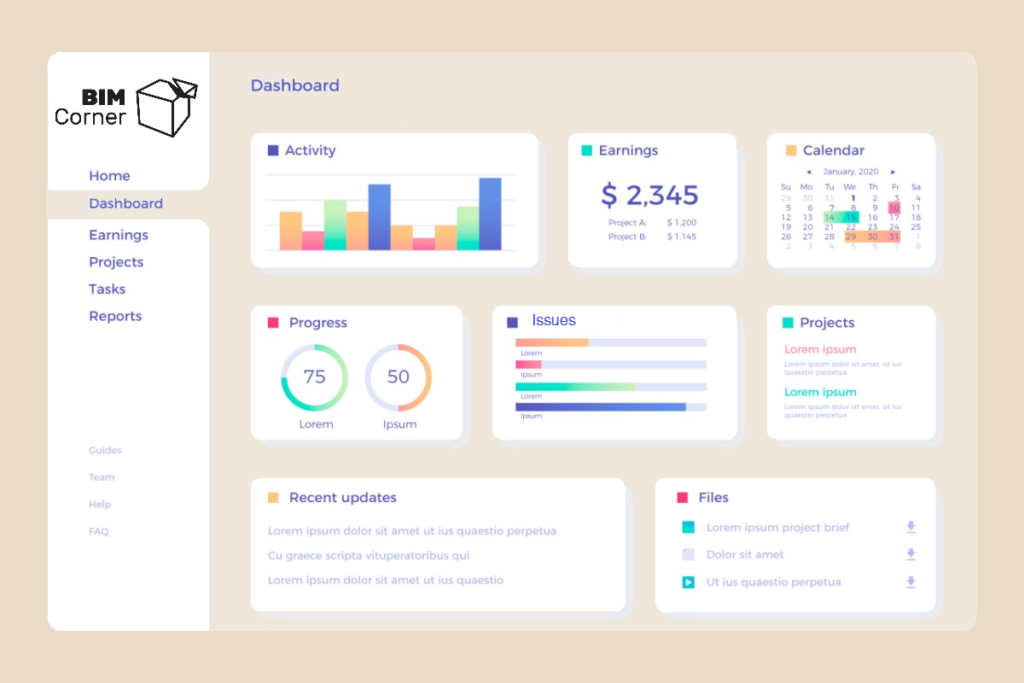Welcome to the series of articles about VDC – Virtual Design and Construction. This series will give you an idea of what the VDC methodology really is. What are its main components? How does it work? What makes it the most effective method of conducting a construction project available on the market today? You will find answers to these questions and much more in this series.
In the first part, you will learn the definition and the whole structure. We will start with the basics and the dependencies between the individual elements. With each subsequent article, we will break it down into bite-sized pieces, to give you a chance to understand all VDC issues easily in detail.
Tabel of content
1. VDC – isn’t it just another useless acronym?
The VDC acronym was first formulated and introduced as a concept by CIFE – Center for Integrated Facility Engineering at Stanford University of California already in 2001, while BIM was actually still in its infancy. The main initiator of the methodology is Professor Martin Fischer, director of CIFE. VDC has
been used for over 15 years in many countries around the world. Over the years the method has been tested and improved with every new project.
The implementation process started mainly in the United States and Scandinavia, later in Switzerland, Singapore, and Peru. Norwegian and Swedish companies were one of the first countries in the world to notice its potential. They began sending their employees to Stanford University in the USA to learn and implement the method in their companies. Nowadays, all major construction companies in Norway employ certified experts in their teams, who gradually introduce VDC elements into their daily work as experts.
After several years, the positive effects of the introduced method are visible. First of all, it has significantly reduced the risks related to design and multidisciplinary coordination. The new way of organizing interdisciplinary meetings has reduced their duration and time spent in the decision-making process. Moreover, problem-solving became faster, the number of misunderstandings was reduced and the quality of the results improved.
Okay, VDC is cool.
But let’s get to the point – what VDC really is?
2. What is Virtual Design and Construction?
I often come across misinterpretation of VDC abbreviation, as the majority focuses on the literal translation of VDC. Some people interpret it as just another BIM level, whereas others think it’s BIM 4D and 5D, a three-dimensional model with additional information on schedule and costs. There is some truth to it, but only some. So how to understand it?
Let’s start by breaking the acronym down into individual words.
Virtual – through the name of the method, the creators aimed to add some freshness to the industry. The method was innovative for those times and differed from the traditional approach. Therefore, the word “virtual” was supposed to mean something new and modern. It can literally be interpreted as a creating a digital twin of the construction. Thus, planning and constructing the construction virtually before the symbolic groundbreaking on the construction site.
Design and construction – these are in fact the two phases where we can create the greatest value to the project. The name may suggest that the methodology is only intended for designers and contractors, but VDC focuses on the entire life cycle of the object.
A literal interpretation of the acronym may, therefore, look as follows: creating a digital twin in the design and construction process. The method can be considered as an aid in the correct use of the created digital model. However, such an interpretation tells us nothing. Therefore, we need to dig deeper.
3. Definition of Virtual Design and Construction
For those looking for knowledge concerning VDC, the Wikipedia definition (formulated by Professor Martin Fisher and John Kunz in 2004) may seem very difficult and complicated:

… which it is indeed. Let’s try to explain it as simply as possible:
First of all:
VDC refers mainly to people. People working together on multidisciplinary projects and in different teams. Modern technology of organizing meetings helps to work in an integrated and simultaneous way.
Second of all:
Teams need new technologies to create digital twins – product delivered to the customer at the end.
Third of all:
Even the best employees and the latest methods won’t bring the desired result if the work isn’t done in the right scheme and process.
More than that:
Core of VDC is collecting data throughout the project. Monitoring iton an ongoing basis allows to determine the status of the project and introduce corrections if necessary. Such a defined structure should help to achieve commonly defined project objectives. These, in turn, should be directly aimed at achieving the objectives set by the client.
Putting it together:
VDC is a combination of new technologies (BIM) with an adequate work and management scheme (PPM), supporting people working together on the project, in an integrated and simultaneous way (ICE). The scheme is focused on achieving the project's objectives, which should help the client to achieve their goals while collecting data and tracking workflow progress.

4. VDC framework
The following diagram illustrates the structure of the VDC method. It is divided into three categories corresponding to the following questions: How? What? Why? Let’s start from the very bottom of the diagram – bottom-up.
4.1. Why is the client doing the project?
All right, let’s start with a football analogy
What is the greatest secret of a good football team? There can be a variety of answers. Many will probably answer that it is the number of talented players in the team or the right tactics for the team or the skills and experience of the coach. All of these answers are correct. However, the biggest secret, and at the same time the most trivial one, is to ensure that all players know who is their opponent and which goal to aim at. Otherwise, no team will be successful. Transferring this to our construction industry: The success of a good project is: that all work on the same project and pursue the same goals.
And here VDC may be considered as an objective management tool. Before starting a project, the customer must determine the important elements of the project. The primary goal of the project must be clearly defined.
Now Example:
Project: Olympic Stadium
Customer’s objective: Building must be finished on time.
Deadline: beginning of the Olympic Games, namely the opening ceremony at the stadium. The official date is already announced. Coaching staffs prepare the training for a specific date, broadcasting rights are sold, sponsors are confirmed. In a word: putting the project to use after the deadline is not an option.* This is how we have established the most important goal for the client. The next step is to set the project goals.
* Let’s be honest, in the real world, the commissioning of the stadium exactly on the day of the opening ceremony is almost as ridiculous as the day after. But, in favor of the above example, let’s overlook and move on.
4.2. What does the project team need to achieve?
These goals must be set in such a way that they lead to the fulfillment of the customer’s predefined objectives. Initially, the team should carry out an analysis of the possible risks to meeting construction deadlines. Of course, there are many design goals that the team can focus on, but the most important ones must be directly related to the customer’s goals. Referring back to the stadium example, the biggest threat will be the design and construction of the roof steel structure.
Project objective: 100% of the milestones for roof steelwork achieved on time.
4.3. How does the project team accomplish the project objectives?
VDC includes three key elements here – the main ICE, which is supported by BIM and PPM. I know, I know another acronyms. Relax, each of them will be discussed in more detail in the following articles. Meanwhile, just briefly:
- ICE - Integrated Concurrent Engineering - is a method of conducting interdisciplinary meetings with the use of modern visualization technologies, where simultaneous design works are conducted. This makes it possible to introduce and approve changes during an all-day working session. Team X from NASA Propulsion Laboratory was the firs to develop this method in the mid-1990s and use it to organize space missions in a more efficient and coordinated way.
- PPM - Product Production Management - a method to establish a production process. A process which defines the workflow schedule and the required resources. PPM employs tools such as the Last Planner System or visual planning methodology to manage processes that are essentially based on LEAN Construction.
- BIM – Building Information Modeling - the basis of BIM has been extensively discussed in these two articles: Everything you should know about BIM and Why should I use BIM technology. BIM plays a significant role in VDC. Above all, it supports decision-making processes. Design challenges can be easily presented to the project team or the customer. Moreover, it is used for construction planning, due to additional schedule information, i.e. 4D.
5. Metrics
Above all, metrics are key to VDC. Taking measurements should be done daily or weekly in order to perform good result evaluation afterwards. The individual objectives of each of three elements should be controlled during the project. It allows making corrections leading to a better process.
Here we distinguish two types of data collection:
A) Production objectives – the objectives we can easily check. They help us to control whether the project is heading in a given direction. The person responsible for introducing VDC in a company can define such goals on its own.
It can be, for example, weekly checking of the number of collisions resolved between branches in one ICE session, or the number of model checks carried out in a month, etc.
B) Controllable factors– these are factors over which we have influence and can decide on them. As opposed to production objectives, we can plan them and decide whether to implement or stop them.Controllable factors should be directly linked to the production objectives of each element (BIM, PPM, ICE).
In this case, we can control, e.g. the number of days between the meeting and the sent agenda. The earlier the agenda is sent, the more branches will have time to prepare, and this will allow resolving more collisions in one session.
6. Virtual Design and Construction - for whom?
Contrary to common opinion, VDC is not just a tool for specialists! VDC is for everyone since it relies on interpersonal interaction. It requires a high degree of commitment, regularity, and responsibility of all participants in the construction process – from investors and designers to contractors. Such a scheme allows to constantly improve the working method.
In conclusion…
…VDC is a completely new way of thinking. Method with modern approach of condacting the project, managing information, and organizing people and their working methods. It helps to achieve the project objectives to the greatest extent, as the whole work is based on them. VDC discusses how to cooperate in different disciplines, how to communicate, plan, and make decisions.
If you liked the article, subscribe to our newsletter. By doing so, you will not miss any more VDC articles. Also, if you’re interested in the methodology and have questions, do not hesitate to write. We respond to every email! [email protected]
The author of this article was inspired by the book Integrating Project Delivery by Martin Fischer, Howard W. Ashcraft, Dean Reed i Atul Khanzode.
Next article from series called ,,Everything about VDC" :
Did you like that post ? Share it with others !
We spend a lot of time and effort creating all of our articles and guides. It would be great if you could take a moment to share this post !
Share:
Comments:
Author:

Download BIM CASE STUDIES:
After reading this guide you will learn:
- How BIM is used on the biggest projects in Norway
- What were the challenges for the design team and how were they solved
- What were the challenges on the construction site and what was our approach to them

Newest articles:
















Dear Mr. Wojslaw,
Thanks for your article on VDC. It is very clear and well written. However, there is one glaring mistake when it comes to your definition of Project Production Management. PPM is defined by the Project Production Institute as “The application of Operations Science theories, principles and methods to better understand, control and improve project delivery.”
See https://projectproduction.org/new-to-ppi/ for introduction to the massive body of knowledge supporting PPM. There is some overlap with Lean Construction but PPM is much more rigorous and practical in theory and application.
Thanks for your comment. I haven’t seen the definition described by PPI. I will study that for sure.
On BIM Corner Blog, we always try to share our knowledge and experience in a practical way – easily accessible for everyone. We avoid hard to understand definitions, primarily general descriptions.